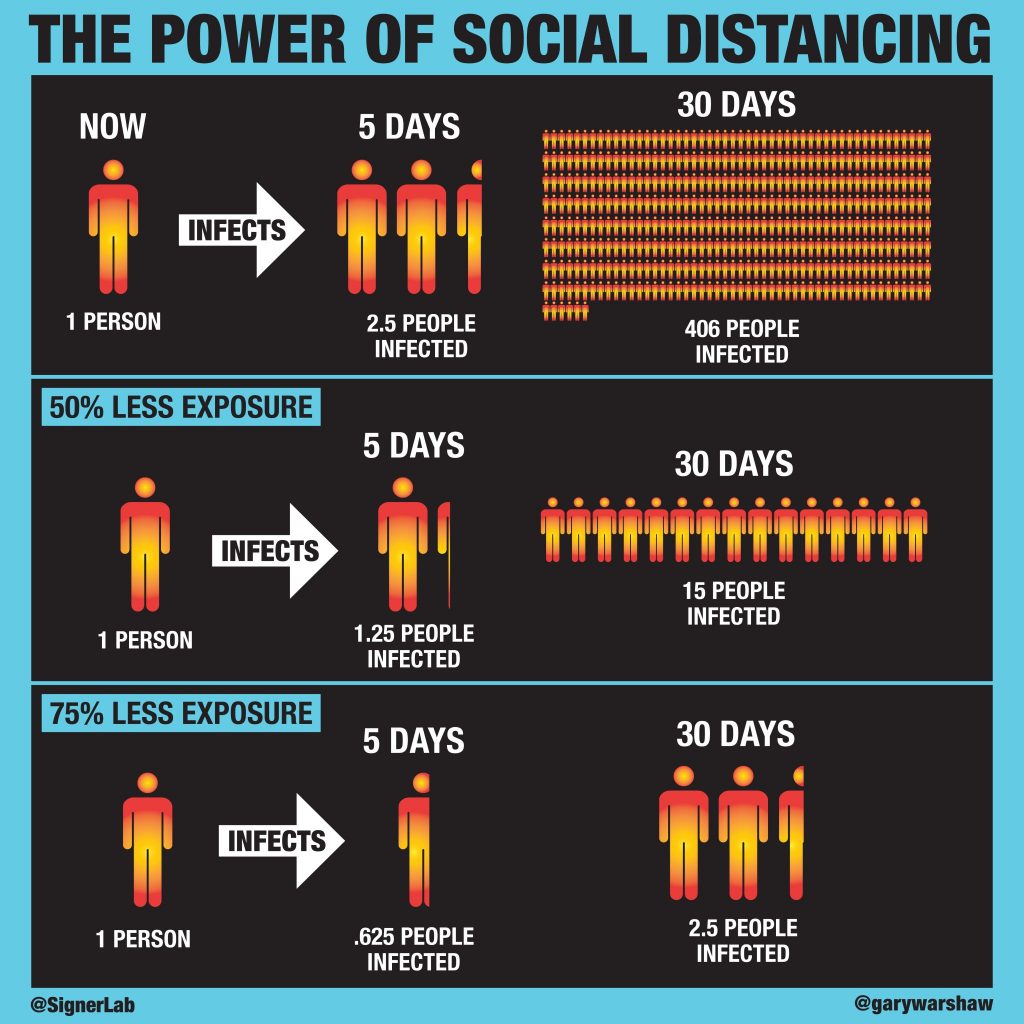

March 25, 2020
COVID-19 UPDATES
Hello Wise Patients! First, THANK YOU. Your feedback and engagement with this publication is so appreciated. We love hearing what content is useful or educational, and encourage you to share this information with any members of your network who could benefit. We are so grateful for the opportunity to care for such an invested and conscientious community. Let’s continue supporting one another.
TOPICS COVERED IN THIS EDITION:
-Social Distancing: Gov. Inslee’s Stay Home, Stay Healthy Initiative
-Treatment for COVID-19: Ongoing Research Updates
-A Timeline for COVID-19 Vaccine Development
-COVID-19 in a Larger Social Context: Implications of blame assignment
-Tips for Avoiding Misinformation Regarding COVID-19
Social Distancing: Stay Home, Stay Healthy
Governor Inslee issued an executive order on March 23rd requiring all Washington residents to stay home. The order is aimed to minimize contact between individuals and therefore the spread of the coronavirus in an attempt to minimize the chance of our hospitals being overwhelmed. Individuals can still carry out essential functions like grocery shopping, going to the pharmacy, and getting exercise outside (running, walking, gardening) as long as they are able to maintain a distance from other individuals of 6 feet. Refraining from these activities and staying home if you are feeling sick remains imperative.
We know the prospect of continued social distancing may feel disheartening and isolating so we wanted to share data that shows how social distancing makes a powerful difference in containing COVID-19. From today’s edition of the New England Journal of Medicine:
“A new Lancet Infectious Diseases study strengthens support for strict social distancing measures to help limit the spread of SARS-CoV-2, the virus that causes novel coronavirus disease (COVID-19).
Using simulation models, researchers in Singapore estimated the number of SARS-CoV-2 infections that would occur at 80 days after the first 100 cases of community spread were confirmed, assuming that 7.5% of infections were asymptomatic. In a scenario when the virus was least infectious (assuming each case infects another 1.5 people), a median 279,000 infections would occur by day 80. This would decrease with increasing social distancing measures, dropping to 1800 when all of the following were enacted: isolation of infected individuals plus family quarantine, workplace distancing, and school closures.
Of note, assuming a more infectious virus (1case infects another 2.5 people), there would be over 1.2 million infections at day 80 with no social distancing measures — & 258,000 with all measures in place.”
Another facet of the Stay Home, Stay Healthy order is for non-essential businesses to close. The attached Seattle Times article goes into detail about what constitutes an essential business. Healthcare is considered essential and as such we are open. We continue to be available for in person visits if there are issues that need to be addressed in person. For issues that can be addressed successfully at a distance through chat, phone or video appointments, we continue to lean into our ability to do this.
Updates on Investigational Treatments
Chloroquine and Hydroxychloroquine are old antimalarial and anti-rheumatoid medications that have activity against coronavirus in the lab. However, preliminary observations are mixed for their use in hospitalized patients with COVID19.
Chloroquine is currently part of the protocol in China for COVID19 treatment. Hydroxychloroquine is currently under investigation in clinical trials for pre-exposure or post-exposure prophylaxis of SARS-CoV-2 infection, and treatment of patients with mild, moderate, and severe COVID-19. More information on trials can be found at: https://clinicaltrials.gov/
There is no current available data from Randomized Clinical Trials (RCTs) to inform clinical guidance on the use, dosing, or duration of hydroxychloroquine for prophylaxis or treatment of SARS-CoV-2 infection.
Because we adhere to the principle of ‘first, do no harm’, and because we are strong adherents to the practice of evidence-based medicine, we are not providing prescriptions for these medications at the current time. This may change as evidence and data comes in.
Antivirals such as lopinavir and ritonavir did not provide clinical improvement in trials in China and are not being used in the US. Remdesivir is under trial usage only for ill inpatients but has no current role for mild illness or for preventing illness.
A timeline for COVID-19 vaccine development:
Various phase 1 vaccine trials for COVID-19 are being launched, including a prominent one here in Seattle at Kaiser’s Research Institute to assess a mRNA vaccine that showed promise in animal models: https://tinyurl.com/wcyl27j. The prospect of having a vaccine for widespread use against COVID-19 is exciting and hopeful, but here is why it won’t be available in the immediate future. A phase 1 trial (the Seattle one at KP enrolling 45 people) to assess safety takes several months. Once it passes that initial safety hurdle, a phase 2 trial would begin and enroll 100’s to 1000’s of people within an area that has a high rate of active infection occurring. A phase 2 trial takes another 6-8 months (ish). From there, a phase 3 vaccine trial involves a yet larger number of people to further test for efficacy and safety. Even if the phase 2 and phase 3 trials are combined/overlapped in the interest of urgency, you can see why the entire process takes over a year. The thoroughness of this timeline is necessary. If we were to just start handing out an untested vaccine for a disease that, albeit horrible for some, 80 percent of people can lick at home on their own, and were that vaccine to prove harmful to many and not protective against COVID-19, the net human harm from the vaccine could be substantial and sad.
On the upside, some scientists studying different samples of the SARS-CoV-2 virus have been observing that the mutation rate may be low enough for a single vaccine to protect for years, rather than a need to create a new vaccine every year like for influenza (ref = newspaper quote of a Hopkins molecular geneticist: https://tinyurl.com/v4mxb8z). Of course more science is needed before going to the bank on that one.
On the blame game:
As we look back in more detail on global, national, and local responses to COVID-19, which we will need to do in order to learn lessons we can pay forward to the next pandemic, we hope we can all blame the virus first. A friend of Wise Patient’s is a hospitalist physician at Evergreen Hospital, where everybody stepped up so dang well to the initial local outbreak that they deserve every bit of praise given them. In discussing the blame game at Wise Patient, we harvested two of this physician’s ‘first impression’ text messages to us during the early phase of his team’s COVID-19 combat at Evergreen that we share with his permission:
“Am really sad how Life Care Center of Kirkland has been portrayed. I’ve always been impressed with that place and they have been roasted unfairly.”
“Setting aside the human toll, it is worthy of awe to see how a non-living speck of proteins can take advantage of our biology, our geography, and our psychology to go from nothing to creating millions of factories creating billions of copies each of itself. It is a triumph for the little guy, a plucky tale of pulling up by one’s bootstraps. And it is definitely good for curbing our smugness and hubris. I think it will also bring out the worst in us for a while, but, eventually, because it will affect everyone, may result in us being just a little more understanding.”
Reliable Sources to Stay Updated on the COVID-19 Outbreak
As you know, we are big proponents of patient-empowered learning. However, as COVID-19 knowledge and recommendations rapidly evolve, this has unfortunately created avenues for misinformation to gain traction. It can be difficult to wade through all these sources.
Tips for avoiding misinformation while researching & reading:
-
If you read a medical term you are not familiar with, try using it as a search term on the WHO or CDC website for more information or to confirm the source is using the term appropriately
-
When reading an article review the sources it references. Most reputable sources have in-text citations and a comprehensive bibliography at the end of the publication. A lack of sources usually means lack of credibility.
-
Not all scientific studies are created equal. In broad terms,
-
Studies with larger sample sizes are more reliable
-
Random-controlled trials are the gold standard
-
Statistical analysis is imperative for assessing the significance of the findings in any study
-
-
There are many free, reliable sources of information so tread lightly with sources that require payment for any access.
-
The FBI has recently reported an increase in fraudulent schemes surrounding the pandemic. Common forms of such crimes include: phishing emails, fake CDC emails & fake treatment or equipment offerings. Here’s their recommendations for avoiding such scams
We are trying our best to pair Wise Patient’s COVID-19 strategy with the information and recommendations we are receiving from local, regional, and national health leadership. Time allowed, we also dig deeper into the scientific literature on important topics. These are among the links we most often access. Feel free to share your go-to sources with us as well.
-
Start at WHO/CDC and UpToDate
-
https://www.who.int/emergencies/diseases/novel-coronavirus-2019
-
https://www.uptodate.com/contents/coronavirus-disease-2019-covid-19#H1323623889. Five stars. UpToDate is a normally pricey source of expert level summary of the medical literature made actionable for our everyday lives as physicians. UpToDate has removed the paywall for COVID-19 related material, in part so the public who invests the time can be essentially as updated as their personal physicians are. Outlined as Intro, Epidemiology, Virology, Clinical Features, Evaluation and Diagnosis, Management, Prevention, and Special Situations.
-
-
Epidemiology:
-
https://www.worldometers.info/coronavirus/country/us/: in addition to country level stats, presents daily updated state by state cases/deaths in the U.S.
-
http://www.centerforhealthsecurity.org/resources/COVID-19/index.html: Johns Hopkins’ situational updates, map, country level stats of confirmed cases and deaths:
-
-
Scientific literature hub:
-
https://www.ncbi.nlm.nih.gov/research/coronavirus/: a search engine of scientific literature from medical and scientific journals related to COVID-19. Allows you to dig deeper / check references on information presented in common news.
-
-
New England Journal of Medicine, free: https://www.nejm.org/coronavirus
-
Risk assessment tool: https://www.humandx.org/covid-19/assessment
-
Local Sources:
-
UW Medicine: https://www.uwmedicine.org/coronavirus
-
King County Public Health: www.kingcounty.gov/covid
- Washington State Dept. of Health call center: 1-800-525-0127
-
If you have any questions, please contact our office at: info@wisepatientim.com
